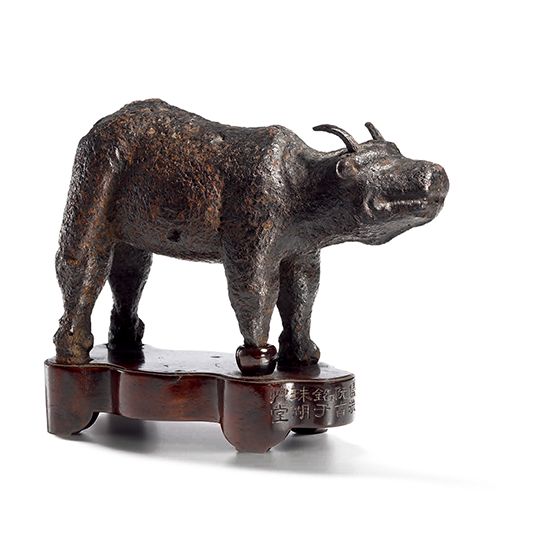CATALOGUE 2014
Southern Song Dynasty (1127-1279); Painting Circa 1921
Length Of Ox: 17.1cm
Length Of Painting: 215cm
The piece is cast in the form of an ox, forward facing with its horns gently pulled back and head turned slightly upward revealing a gentle smile. The ox rests on a deeply patinated hongmu stand with an inscription which reads:
南宋物多尚鐵錢 。亦然況此犢 。是犢當年塚中得 。前蹄已久斷其一 。阮氏寳之樂無極 。儀徵阮亨銘于珠湖草堂 。
Of objects from the Southern Song era, people mostly esteem iron coin cash — but how much more should they esteem this ox calf! When the calf was obtained from a grave mound this very year, it was discovered with one of its front hooves broken off, apparently long ago, but the Ruan family finds it endlessly delightful. Inscription made at the Zhuhu caotang (Pearl Lake Cottage) by Ruan Heng of Yizheng.
Ruan Heng’s note implies that the grave could be dated to the Southern Song era. “Pearl Lake Cottage” was a building on the Ruan clan estate, now within the city of Yangzhou, which served as a study and library. Yizheng is the name of a county district that now lies within greater Yangzhou. An account of the Pearl lake Cottage is contained in Yangzhou fuzhi 揚州府志 (Gazeteer of Yangzhou Prefecture) 31:44b.
Ruan Heng 阮亨 (1783-1859), personal name (zi 字) Meishu 梅叔, sobriquet Zhongjia 仲嘉, was the younger paternal cousin of the prominent later Qing literatus Ruan Yuan 阮元 (1764-1849). His extensive literary works in various genres were published as the Chun caotang congshu 春草堂叢書 (Collectanea from the Springtime Cottage), as well as a separate collection of classical verse, the Zhuhu caotang shichao 珠湖草堂詩鈔 (Draft Collection of Verse from the Pearl Lake Cottage), the Qinyan ji 琴言集, and the Yingzhou bitan 瀛舟筆談 (Brush Talks [miscellaneous jottings] from the Boat to the Fairy Isles), among others. He also edited an enormous work on the study of the Mencius, as well as several anthologies of contemporary regional poets.

The ox is in compendium with a calligraphic scroll by its previous owner, Tomioka Tessai, and consists of a painting of the ox on the stand and a running script calligraphic prose entitled 鐵牛古像の記事稿 “Draft Record of the Ancient Figure of an Iron Ox.” The record is an account of his relationship with the “Iron Ox”, in which he states that he first saw the object some “fifty years earlier” in Kyo- to,that is during the late 1860s, a time that he then goes on to reminisce about. He then says it had various owners before he himself acquired it, but unfortunately does not say when this happened or where. He and its previous owners greatly admired and treasured the “Iron Ox”, considering that though rustic, it had a rare elegance. The record is signed at the end: 八十又六鐵齋老人百鍊 “At the age of eighty-six, Old Man Tessai, Hyakuren.” Since Tessai was born in 1836, the record can be dated to 1921. Signature followed by one of Tessai’s seals.

Tomioka Tessai 富岡鉄斎 (1836-1924): His given name ( 名) was Hyakuren 百練, personal name ( 字) Muken 無 倦, sobriquet Yu- ken 裕軒, changed later to Tessai 鉄斎 or Tetsugai 鉄崖, and he was also known as Tetsu Do- jin 鉄 道人. He was born and raised in Kyo- to, and spent most of his adult life there. Tessai received an excellent literatus education, which stressed traditional Japanese National Learning, Buddhism, Confucianism, especially the tradition of Wang Yangming. At the transition from the shoganate to imperial rule (the Meiji Restoration) in the 1860s he became an ardent supporter of the new movement. After the restoration in 1868, he traveled extensively throughout Japan, observing customs, studying geography, local history, and served at various places as chief priest of Shinto- shrines. In 1881 he returned to Kyo- to, where he devoted himself full-time to painting, and gradually acquired a prominent reputation, making a good living from his art. He had studied painting seriously from the age of nineteen, and was especially influenced by Ming and Qing literati painting ( 明清画), though he also liked painting directly from nature, so developed a real individual style of his own. Tessai is generally considered the last great Japanese Nanga 南画 “Southern-style” painter, associated with Southern Song literati painting and its later Ming resurgence. His paintings and calligraphic pieces are treasured in Japan and are held in many museums. An entire museum is dedicated to his works in Takarazuka,
PROVENANCE
Tomioka Tessai 富岡鉄斎 (1837-1924)
Ruan Heng 阮亨 (1783-1859)
南宋代 鐵牛和鐵牛古像の
記事稿字畫
(字畫1921 年)